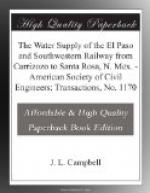The joints are formed by turning a chamber in one end of the pipe and a tenon on the other, or both ends are turned to a true exterior circle and driven into a wood or steel sleeve. The chamber and tenon were used in this work.
Finally, each piece of pipe is covered with as much hot asphalt as it will carry.
Steel Bands.—The specifications required bands of mild steel, of 60,000 lb. strength, with an elastic limit half as great. The winding was spaced to limit the tension to 15,000 lb. per sq. in. If severe water-hammer is present, the ordinary working stress should be materially less than the latter, otherwise the spiral bands will stretch enough to permit the water to spurt out between the staves. This was determined to be true on 4,500 ft. of 12-in. pipe connecting the Carrizozo Reservoir with a water column at the roundhouse there. In pumping tests at the mills, attempts were made, at various times, to burst the pipe, but they never succeeded. Before the elastic limit was exceeded, the water was running out between the staves as fast as the pump forced it in. On the following day, pipe thus tested would carry the pressure for which it was designed without leaking. Except for defects in the band, pipe of this kind will not burst in the service for which it is properly designed. This is true, without exception, of the 100,000 pieces of pipe in this service.
There has been some trouble with a number of the riveted splices on the banding. Such a splice occurs for every spool of banding used. In every case where one of these splices has pulled apart, the break was the result of defective riveting, permitting the rivets to pull out. In no case has a rivet been found sheared off, and even one good rivet appears to be sufficient to prevent rupture. The explanation is found in the high frictional resistance between the band and the pipe, which distributes the weakness of a bad splice over several adjacent turns of the band around the pipe. The band loosens a few turns only on either side of a parted splice, generally not more than three. In no case has any pipe been removed from the trench, repairs being made without interruption to the flow of water.
It is desirable to substitute welding for the riveting of these splices. The trouble is not present with the round band, the wrapped splice of the latter giving practically 100% efficiency.
The flat band was chosen for this work because it is the more effectively buried in and protected by the asphalt, and will not crush the soft wood staves under high pressure. The longevity of either the flat or the round steel band is dependent primarily on effective protection against contact with corrosive elements. Wrought iron should be used for this kind of service, and, for the same reason, for many other purposes. Engineers and consumers should join in some comprehensive and effective plan to bring back the old-time production of high-grade wrought iron.




